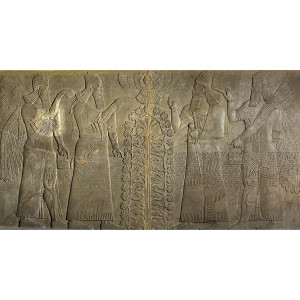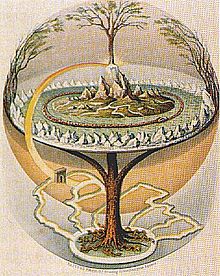
Besides its presence in the books of Genesis and Revelation in the Bible, the idea of a tree of life is present in various religions and mythologies. It existed in Persian mythology, as the Gaokerena world tree, which had healing properties when eaten and gave immortality to the resurrected bodies of the dead. To ancient Egyptians, the Tree of Life represented the chain of events that brought creation into existence. In Chinese mythology, a carved Tree of Life depicts a phoenix or a dragon—which represented immortality. In the Book of Mormon, the tree of life symbolizes the love of God. In the Norse religion the tree of life is Yggdrasil, the world tree.
There is a sacred tree motif in ancient Near East art, but no literature of the time that clearly links it with the tree of life. The Assyrian relief in the above photo was originally in the throne room of the Palace of Ashurnasirpal II, who reigned from 883-859 BC. His reign over Assyria would have been concurrent to that of Ahab in Israel (873-853 BC) and Jehoshaphat in Judah (873-853 BC). Ashurnasirpal is pictured twice, on each side of a Sacred Tree. The figure of the king on the left is gesturing to the Sacred Tree, a symbol of fertility and abundance given by the gods. The figure of the king on the right gestures to a god within a winged disk above the Tree, possibly Shamash, the god of sun and justice or Ashur, the national god. For more information on this stone relief, try the link here to the British Museum.
So what makes the Bible’s use of the sacred tree, the tree of life unique? In Genesis, it was in the midst of Eden, the garden where humanity had fellowship with God (Genesis 3:8). Adam and Eve sinned by disregarding God’s command to not eat from another tree, the tree of the knowledge of good and evil. They wanted to be like God, knowing good and evil independent of His counsel and command. This rebellion ruptured their fellowship with God and He banished them from Eden. Banishment also prevented them from eating from the tree of life and becoming immortal (Genesis 3:22). So death and separation from God became consequences of their sin.
According to E. B. Smick in The International Standard Bible Encyclopedia, the tree of life can symbolize Adam and Eve’s continued relationship with God. Access to it is contingent upon their maintaining obedience to God’s commands. “The most significant thing about the tree of life theologically is that when our first parents broke their relationship with God through disobedience they were driven from the Garden ‘lest he put forth his hand and take also of the tree of life, and eat, and live for ever’” (Genesis 3:22).
Adam and Eve were on probation in the Garden. They were not yet permanent (regenerated) spiritual children of God. The tree of life from this perspective is a type of Christ, through whom eternal life is possible. The uniqueness of how the tree of life is portrayed in Scripture signifies how the person and work of Christ restores access to it.
Partaking of the tree of life implies not only continued probation (negative obedience) but also a positive commitment analogous to what believers do in the Lord’s Supper and what the OT saints did at the sacrifices.
In his commentary on Genesis, Gordon Wenham noted how trees as a symbol of life corresponded to items in or near the center of Israelite worship throughout the Old Testament. Genesis 3:22 of course noted that this tree conferred life on those who ate it. Proverbs described wisdom (3:18), the fruit of the righteous (11:30), a desire fulfilled (13:12), and a gentle tongue as a tree of life. In other words, they gave fullness of life to their owners.
Trees, because they remain green throughout the summer drought, are seen as symbolic of the life of God (e.g., Psalm 1:3; Jeremiah 17:8). In Genesis 21:33 Abraham prayed by a tamarisk tree he planted. It seems likely that the golden candlestick in the tabernacle was a stylized tree of life (Exodus 25:31-40). The Dictionary of Biblical Imagery also affirmed this symbolism: “It is very likely that this lamp symbolized the tree of life in the garden of Eden.” Lamps in general also had a symbolic connection to the tree of life. The lamp in the shrine at Shiloh is called “the lamp of God” in 1 Samuel 3:3. In Psalm 119 the Word of God is exalted as “a lamp to my feet and a light to my path.”
This imagery continues into the New Testament, where Jesus said in John 8:12 that he was the light of the world; that whoever followed him would not walk in darkness, but would have “the light of life”—eternal life. When the New Jerusalem comes down from heaven in Revelation 21, lamps are no longer needed, because “its lamp is the Lamb” (Revelation 21:23).
The gift of life offered by the Tree of Life in the Garden of Eden is now offered in the person of the Word incarnate. By believing in Jesus, humans partake of the eternal life he offers (John 3:16). Or, more vividly, by eating the flesh and drinking the blood of Christ, they gain eternal life and will be raised on the last day (John 6:54).
In Revelation, humanity is granted access once again to the tree of life and may freely eat of it (Revelation 2:7; 22:2). So Revelation depicts a reversal of the damage done at the beginning by the sin of Adam and Eve. Fellowship and relationship with God is restored. Revelation 22:2 also suggests the leaves of the tree of life have a sacramental role or purpose in that they are for “the healing of the nations.” The Dictionary of Biblical Imagery commented how “The Bible’s story of salvation history begins and ends with references to symbolic trees.”
The tree of life in Genesis then represents the relationship humanity initially had with God, but lost through their rebellion. This loss was not to be a permanent one, as it was also a type of Christ—a representation of the planned restoration of relationship with God through the finished work of Christ. It is not until this side of the completed of the work of Christ that we could see how he restored relationship with God, in effect becoming the lamp and light of life.
 The biblical tree of life is then much more than a world tree that supports the heavens, upholds the world, and connects both with the underworld, as in the Yggdrasil of Germanic and Norse mythology. It is greater than just being a symbol of fertility and abundance given by the gods in Assyrian mythology; or a plant easily stolen from the King of Uruk by a snake at the end of his quest in the Epic of Gilgamesh. Gilgamesh learned that: “Life, which you look for, you will never find. For when the gods created man, they let death be his share, and life withheld in their own hands.” The Christian quest for the tree of life is one that has the promise of fulfillment one day in Christ. As an anonymous female Puritan wrote:
The biblical tree of life is then much more than a world tree that supports the heavens, upholds the world, and connects both with the underworld, as in the Yggdrasil of Germanic and Norse mythology. It is greater than just being a symbol of fertility and abundance given by the gods in Assyrian mythology; or a plant easily stolen from the King of Uruk by a snake at the end of his quest in the Epic of Gilgamesh. Gilgamesh learned that: “Life, which you look for, you will never find. For when the gods created man, they let death be his share, and life withheld in their own hands.” The Christian quest for the tree of life is one that has the promise of fulfillment one day in Christ. As an anonymous female Puritan wrote:
Faith is the grace, and the only grace, whereby we are justified before God, by it we eate of the Tree of Life, (Jesus Christ) and live forever: It is therefore the fittest grace of all, to satisfie Conscience in this weighty matter, and to make up conclusions from, about our eternall estate. This Satan knows full well, and therefore when he would flatter a man to Hell, he perswades him, that his faith is right good, when indeed there is no such matter; and when he would overthrow all hope of Heaven in a man, and drag him into despaire, he perswades him, that his faith, though never so good, is but a feigned and counterfeit thing, and the poore soul, is ready to say, Amen.
This is the fourth reflection I’ve done on excerpts from Evidence for Heaven, written by an anonymous Puritan female author. Edward Calamy was credited as the author, but he himself acknowledged it was actually written by a female member of his church.




